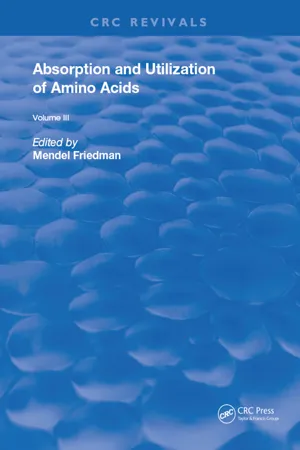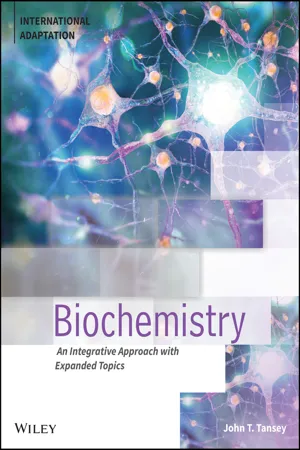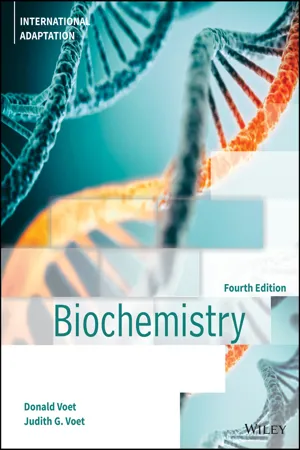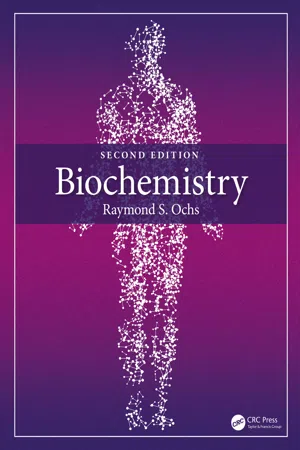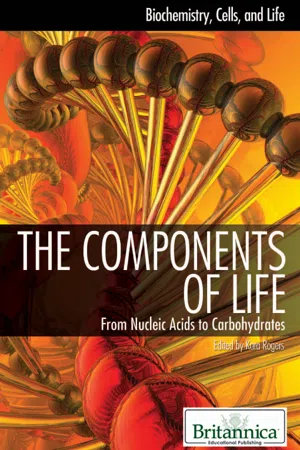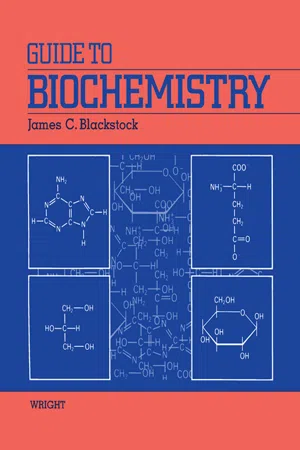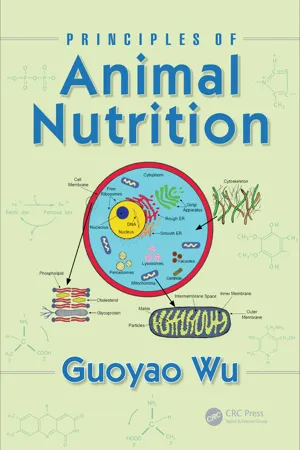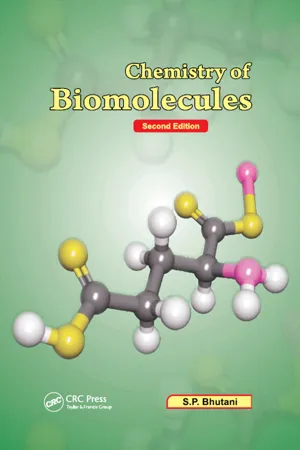Chemistry
Classification of Amino acids
Amino acids are classified based on the properties of their side chains. They can be categorized as nonpolar, polar, acidic, or basic. Nonpolar amino acids have hydrophobic side chains, while polar amino acids have hydrophilic side chains. Acidic amino acids have a carboxyl group in their side chains, and basic amino acids contain an amino group.
Written by Perlego with AI-assistance
Related key terms
Related key terms
1 of 4
Related key terms
1 of 3
11 Key excerpts on "Classification of Amino acids"
- eBook - ePub
- Mendel Friedman(Author)
- 2018(Publication Date)
- CRC Press(Publisher)
2 ). Classification according to structure and properties are even more important when methods of analysis for nonprotein amino acids are considered.III. NOMENCLATUREThe nomenclature of amino acids is based on trivial names and systematic conventions according to IUPAC-IUB recommendations.7 The trivial names and the abbreviated symbols shown in Figure 2 are recommended for these protein amino acids. Nonprotein amino acids are named as a derivative of the related protein amino acid, or according to generally accepted conventions.8FIGURE 2. Structures, names, standard abbreviations, numbering, and configurations of the 20 genetically coded protein amino acids.The prefix “nor” is used in amino acid nomenclature to indicate “normal” instead of branched carbon chain, e.g., norvaline is [CH3 CH2 CH2 CH (+ NH3 )COO− ] and norleucine is [CH3 CH2 CH2 CH2 CH (+ NH3 )COO−].The prefix “homo” is used to indicate one more CH2 group in the side chain of the amino acid relative to the structure implied by the trivial name, e.g., homocysteine is [HS-CH2 CH2 CH (+ NH3 )COO− ].A. StereochemistryProtein amino acids except Gly have at least one chiral center. The absolute configuration at C-2 in these amino acids is designated with the prefix D - or L - to indicate the correlation with D - or L -serine and these correlate with L - and D -glyceraldehyde, respectively. This simple but ingenious chemical-biochemical classification makes it possible to perform determination of absolute configuration of diastereoisomeric nonprotein amino acids.9 This is important for correct interpretation of structure-properties relation in the big group of naturally occurring 3- and/or 4-substituted acidic amino acids.9 , 10All of the protein amino acids are L -amino acids, except Gly. This means they have (2S)-configuration according to the R,S-system as shown in Figure 2 , if a heavy atom (sulfur) is not present at C-3 as in cysteine (see Figure 2 - eBook - ePub
- Robert J. Ouellette, J. David Rawn(Authors)
- 2015(Publication Date)
- Elsevier(Publisher)
side chain. There are 20 different R groups in amino acids isolated from proteins. Of these 20 α-amino acids, 19 are chiral; they have the L configuration. The one that is not chiral is glycine: its R group is hydrogen.Classification of Amino acids
The amino acids in proteins are primary amines except for proline, which is a secondary amine. Three-letter abbreviations of the amino acids, used as a short-hand to describe protein structure, are given in Figure 14.1 . (An alternate one-letter shorthand method exists, but we will not use it in this text.)Figure 14.1 Structures of the α-Amino Acids at pH 7At pH 7 the α-amino and α-carboxyl groups are both ionized.The amino acids are classified by their side-chain R groups as neutral, basic, and acidic. Neutral amino acids contain one amino group and one carboxyl group. The neutral amino acids are further divided according to the polarity of the R group. Serine, threonine, and tyrosine are neutral amino acids that are also alcohols. Phenylalanine, tyrosine, and tryptophan contain aromatic rings. Cysteine and methionine contain a sulfur atom. The remaining neutral amino acids have hydrocarbon side chains.The three basic amino acids, lysine, arginine, and histidine, have a basic nitrogen-containing functional group in the side chain. The two acidic amino acids, aspartic acid and glutamic acid, have carboxylic acid side chains. The acidic amino acids also have close relatives, asparagine and glutamine, that have neutral amides in the side chains.Amino acids are also classified by the tendency of their side chains to interact favorably or unfavorably with water. Those amino acids with polar side chains are said to be hydrophilic; that is, water-loving. Those whose side chains are nonpolar are said to be hydrophobic. Hydrophobic amino acids have alkyl or aromatic groups that do not form hydrogen bonds to water.14.3 Acid–Base Properties of α-Amino Acids
The α-amino acids that do no have acidic or basic side chains have no net - eBook - ePub
Biochemistry
An Integrative Approach with Expanded Topics
- John T. Tansey(Author)
- 2022(Publication Date)
- Wiley(Publisher)
• Amino acids are small organic molecules containing both an amino group and a carboxyl group. Most are chiral and, in nature, the L enantiomer predominates.• Twenty amino acids are commonly found as components of proteins.• The amino acids found in proteins can be categorized by their side chains, which have diverse structures and chemistry, and contribute to the overall structure and properties of proteins.• Amino acids serve other roles in biochemistry. For example, they act as metabolic intermediates and signaling molecules.Concept Check1. Categorize the amino acids by property or functional group.2. Describe how each amino acid is unique with regard to its structure and chemistry.3. Identify which parts of an amino acid are ionizable and give the pK a of those groups.4. Discuss the zwitterionic state of amino acids.5. Explain on a chemical level why and how the immediate environment contributes to the pK a of a group.3.2 Proteins Are Polymers of Amino AcidsAmino acids play several important roles in biochemistry but are chiefly used as building blocks for peptides and proteins. This section begins with a discussion of the peptide bond and its properties, and then discusses cofactors and modifications to amino acids found in proteins.3.2.1 Both peptides and proteins are polymers of amino acidsTwo amino acids can join via an amide linkage between the carboxyl group of one amino acid and the amino group of the next (Figure 3.6 ). This linkage is referred to as a peptide bond , and the resulting molecule is termed a dipeptide. Three linked amino acids are referred to as a tripeptide, four as a tetrapeptide, and so on. Oligopeptides are generally 4 to 20 amino acids long, and peptides of more than 20 amino acids are usually referred to as polypeptides , although these terms are not strictly defined. Short stretches of amino acids are referred to as peptides , and longer chains, generally greater than 100 amino acids long, are referred to as proteins - eBook - ePub
- Donald Voet, Judith G. Voet(Authors)
- 2021(Publication Date)
- Wiley(Publisher)
8 ). According to this classification scheme, there are three major types of amino acids: (1) those with nonpolar R groups, (2) those with uncharged polar R groups, and (3) those with charged polar R groups.a. Nonpolar Amino Acids
Nine amino acids are classified as having nonpolar side chains. Glycine (which, when it was found to be a component of gelatin in 1820, was the first amino acid to be identified in protein hydrolyzates) has the smallest possible side chain, an H atom. Alanine (Fig. 3-6 ), valine, leucine, and isoleucine have aliphatic hydrocarbon side chains ranging in size from a methyl group for alanine to isomeric butyl groups for leucine and isoleucine. Methionine has a thiol ether side chain that resembles an n-butyl group in many of its physical properties (C and S have nearly equal electronegativities and S is about the size of a methylene group). Proline, a cyclic secondary amino acid, has conformational constraints imposed by the cyclic nature of its pyrrolidine side chain, which is unique among the “standard” 20 amino acids. Phenylalanine, with its phenyl moiety (Fig. 3-6 ), and tryptophan, with its indole group, contain aromatic side chains, which are characterized by bulk as well as nonpolarity.Figure 3-6Structures of the α-amino acids alanine, glutamine, and phenylalanine. The amino acids are shown as ball-and-stick models embedded in their transparent space-filling models. The atoms are colored according to type with C green, H white, N blue, and O red.b. Uncharged Polar Amino Acids
Six amino acids are commonly classified as having uncharged polar side chains. Serine and threonine bear hydroxylic R groups of different sizes. Asparagine and glutamine (Fig. 3-6 ) have amide-bearing side chains of different sizes. Tyrosine has a phenolic group, which, together with the aromatic groups of phenylalanine and tryptophan, accounts for most of the UV absorbance and fluorescence exhibited by proteins (Section 8-1Cb ). Cysteine has a thiol group that is unique among the 20 amino acids in that it often forms a disulfide bond to another cysteine residue through the oxidation of their thiol groups (Fig. 3-7 ). This disulfide bond has great importance in protein structure: It can join separate polypeptide chains or cross-link two cysteines in the same chain. Two disulfide-linked cysteines are referred to in the older biochemical literature as the amino acid cystine - eBook - ePub
Understanding Advanced Organic and Analytical Chemistry
The Learner's ApproachRevised Edition
- Kim Seng Chan, Jeanne Tan;;;(Authors)
- 2016(Publication Date)
- WS EDUCATION(Publisher)
CHAPTER 12
Amino Acids
12.1 Introduction
Amino acids are organic compounds that contain both an acidic carboxyl group (–COOH) and a basic amine group (–NH2 ). α-amino acids have both these functional groups attached to the same C atom, known as the α-carbon, and their general formula is RCH(NH2 )COOH.Q:What is an α-carbon?A:α-carbon refers to the first carbon atom that is bonded to a functional group, such as –COOH, –OH, –Cl, –NH2 , –CHO, –COOR, etc. In the case of an amino acid, there are two functional groups, namely the –COOH and –NH2 . Since –COOH has a higher priority than –NH2 , the parent is an acid. The amine group being considered as a substituent is given the prefix, amino. The next carbon atom that is bonded to the α-carbon is known as β-carbon and the following one is the γ-carbon, so on and so forth.Accordingly, the differences among these α-amino acids lie with the type of side chain (R-group) that is attached to the α-carbon. When the R group is an H atom, we have the simplest α-amino acid known as glycine.Apart from glycine, an important feature of the α-carbon of the other amino acids is that the α-carbon is chiral in nature, and this causes them to be optically active and thus exist as a pair of enantiomers.Just like the use of Lego building blocks in creating structures of unique features, different combinations of amino acids in linear chains result in various types of proteins and polypeptides. The proteins and polypeptides in the human body are essentially derived from twenty α - eBook - ePub
- Raymond S. Ochs(Author)
- 2021(Publication Date)
- CRC Press(Publisher)
10.07 Valine val V 2.29 9.745.3.1 Polarities
The overall polarity of amino acids depends on their R groups. Figure 5.4 shows the structures of the polar amino acids. We can further subdivide them into three categories: neutral, acidic, and basic. Figure 5.5 shows the nonpolar amino acids, which are further divided into alkyl chains, branched-chains, aromatics, and a pair of unique nonpolar structures.FIGURE 5.4 Polar amino acids. Three subdivisions shown are: acidic, basic, and neutral.FIGURE 5.5 Nonpolar amino acids. Three major subdivisions are: alkyl, branched-chain, and aromatic. Methionine and proline are the single examples of a thioether and secondary amine, respectively.5.3.2 Functional Groups
Figure 5.6 presents a chemical categorization of some of the amino acids. Here, acids include not only aspartate and glutamate, but also cysteine, histidine, and tyrosine, as these can act as acids under some biological conditions. All of the pK values of the side chains of these acids are shown in Table 5.2 . The bases shown in Figure 5.6 are lysine, arginine, and histidine. The duplicate categorization of histidine means that it can act as both an acid and a base. To understand this phenomenon, consider first the side chain alone, which is an imidazole ring:(5.1)FIGURE 5.6 Functional groups in amino acids. A cross-categorization of amino acids that groups together all acids, bases, and hydroxyl groups. Cysteine and methionine are single examples of the functional groups of sulfhydryl groups and thioether, respectively.Protonation of the neutral histidine ring at the left side produces a resonance-stabilized intermediate with electrons spread over both nitrogens of the ring and the carbon atom between them. Dissociation of this intermediate can proceed either by reversal of the first equilibrium or by loss of a proton from the other nitrogen to produce the molecule on the right side of Equation (5.1). Of course, both of these molecules are the same. The situation is slightly different for the amino acid histidine because the ring is substituted. The ring numbering system is indicated in Figure 5.7 , and the same equilibria now produce a distinct molecule of histidine with the hydrogen attached to a N1 instead of N3. The ability of imidazole or histidine to produce either product from the resonance intermediate explains the low pK of histidine. A further important feature of histidine is its participation in enzyme catalysis (Chapter 6 - eBook - ePub
The Components of Life
From Nucleic Acids to Carbohydrates
- Britannica Educational Publishing, Kara Rogers(Authors)
- 2010(Publication Date)
- Britannica Educational Publishing(Publisher)
CHAPTER 2Molecular Components: Amino AcidA mino acids are organic molecules that consist of a basic amino group (-NH2 ), an acidic carboxyl group (-COOH), and an organic R group (or side chain) that is unique to each amino acid. The term amino acid is short for “α-amino [alpha-amino] carboxylic acid.” Each molecule contains a central carbon (C) atom, termed the α-carbon, to which both an amino and a carboxyl group are attached. The remaining two bonds of the α-carbon atom are generally satisfied by a hydrogen (H) atom and the R group. The formula of a general amino acid is:The amino acids differ from each other in the particular chemical structure of their R group. Of over 100 natural amino acids, each with a different R group, only 20 make up the proteins of all living organisms. Humans can synthesize 10 of them (by interconversions, or mutual conversions) from each other or from other molecules of intermediary metabolism, but the other 10 (essential amino acids: arginine, histidine, isoleucine, leucine, lysine, methionine, phenylalanine, threonine, tryptophan, and valine) must be consumed in the diet.BUILDING BLOCKS OF PROTEINS
Proteins are of primary importance to the continuing functioning of life on Earth. Proteins catalyze the vast majority of chemical reactions that occur in the cell. They provide many of the structural elements of a cell, and they help to bind cells together into tissues. Some proteins act as contractile elements to make movement possible. Others are responsible for the transport of vital materials from the outside of the cell (“extracellular”) to its inside (“intracellular”). Proteins, in the form of antibodies, protect animals from disease and, in the form of interferon, mount an intracellular attack against viruses that have eluded destruction by the antibodies and other immune system defenses. Many hormones are proteins. Last but certainly not least, proteins control the activity of genes (“gene expression”). - eBook - ePub
- James C. Blackstock(Author)
- 2014(Publication Date)
- Butterworth-Heinemann(Publisher)
Today the immense variety of protein molecules is recognized. Proteins are the most abundant macromolecules found within cells and perform a wide variety of functions (Section 1.6). A protein can be considered as a unique polymer of amino acids (Section 1.4) which determine its chemical and structural properties. It is therefore imperative to consider the amino acids before embarkation upon a discussion of protein structure. Of the 308 catalogued natural amino acids, only 20 (plus a few derivatives) occur in proteins in which all are α-amino acids of the L -series (Section 1.3). They conform (except proline) to a general formula (Figure 4.1) in which an amino group and a carboxylic acid group are attached to the α-carbon (C α) atom. Proline, an imino acid, is normally included because of its occurrence in proteins. The properties of individual amino acids vary according to the nature of the R group called the side chain (Table 4.1). Asparagine and glutamine are considered as amide derivatives of aspartic acid and glutamic acid respectively. Tyrosine may be classified either by its hydroxy or aromatic group. To refer to amino acids in polypeptide sequences, three- or one-letter codes are frequently employed. L -α-Amino acids, with the exception of glycine, contain a chiral α-carbon atom (Section 1.3). These amino acids exhibit optical activity; in some cases, dextrorotatory, e.g. alanine, in other cases laevorotatory, e.g. phenylalanine. Because of the conjugated double-bond system of their aromatic rings, tyrosine, tryptophan and phenylalanine absorb light in the ultraviolet region - eBook - ePub
- Guoyao Wu(Author)
- 2017(Publication Date)
- CRC Press(Publisher)
4 Chemistry of Protein and Amino AcidsThe word “protein” originated from the Greek word “proteios ,” meaning prime or primary (Meister 1965). A protein is a large polymer of amino acids (AAs) linked via the peptide bond (–CO–NH–). Different proteins have different chemical properties (e.g., AA sequences, molecular weights, ionic charges, three-dimensional (3D) structures, hydrophobicity, and function). The general structure of an AA is shown in Figure 4.1 . There may be one or more polypeptide chains in a protein, which contains its constituents (nitrogen, carbon, oxygen, hydrogen, and sulfur atoms). A protein may be covalently bonded to other atoms and molecules (e.g., phosphates) and non-covalently attached with minerals (e.g., calcium, iron, copper, zinc, magnesium, and manganese), certain vitamins (e.g., vitamin B6 , vitamin B12 , and lipid-soluble vitamins), and/or lipids. Protein is the major nitrogenous macronutrient in foods and the fundamental component of animal tissues (Wu 2016). It has structural, signaling, and physiological functions in animals (Table 4.1 ).Figure 4.1 Fisher projections for configurations of AAs relative to l - and d -glyceraldehydes. The general structure of an AA in the non-ionized form is shown. For AAs, l - or d -isomers refer only to the chemical configuration of their α - eBook - ePub
- S. P. Bhutani(Author)
- 2019(Publication Date)
- CRC Press(Publisher)
2Amino Acids, Peptides, and Proteins
Learning Objectives In this chapter we will study • Amino Acids, Classification and Stereochemistry • The Essential Amino Acids • Synthesis and Reactions of Amino Acids • Resolution of Racemic Mixture of Amino Acids • Stereoselective Synthesis of Amino Acids • Biosynthesis of Amino Acids • Amino Acids as Dipolar Ions, as Acids and Bases • Isoelectric Point • Separation of Amino Acids • Polypeptides: Nomenclature and Synthesis • Solid Phase Peptide Synthesis • Determination of Primary Structure of Peptides• End Group Analysis – Determination of N – terminal and C – terminal Amino Acids• Some Interesting Peptides • Importance and Biological Functions of Proteins and Polypeptides • Molecular Shape and Structure of Proteins • Denaturation of Proteins2.1 INTRODUCTION
The three important groups of biopolymers are polysaccharides, proteins and nucleic acids. We already know the importance of polysaccharides. They act as food reserves in animals and human beings and in plants as structural materials. Proteins are the most abundant organic molecules in animals and human beings. We consume proteins primarily for growth and maintenance. Any balanced diet must contain an adequate amount of proteins. They perform a variety of functions in living organisms. They are the principal material of muscles, skin, tendons, nerves and blood. As enzymes and hormones, proteins catalyse and regulate the reactions that occur in the body; as haemoglobins they transfer oxygen to its most remote corners. Even in plants, where carbohydrates are more abundant as structural materials, proteins are present in those parts that are responsible for growth and reproduction.The fundamental structure of proteins is simple. Proteins are biopolymers of α-amino acids. They consist of long chains of α-amino acids bonded to each other by amide bonds also known as peptide linkages between the carboyxlic group of one amino acid with the amino group of another. Thus, proteins are high molecular weight polypeptides. Their molecular weight may range from 5000–100,000 units. A single protein molecule contains hundreds or even thousands of amino acid units. About twenty different amino acids are the building blocks of proteins. The number of different combinations, that is the number of different protein molecules that are possible, is almost infinite. - eBook - ePub
Biochemistry Explained
A Practical Guide to Learning Biochemistry
- Thomas Millar(Author)
- 2018(Publication Date)
- CRC Press(Publisher)
4 Amino Acids and their Functions In this chapter you will learn:- the functional groups: an amine and carboxyl groups
- to understand the general structure of amino acid
- the structures, names and single letter symbols for the 20 amino acids found in proteins
- how 2 cysteines may be oxidised to form the bridging amino acid cystine
- how the carbons of amino acids are named or numbered
- the terms ampholyte and zwitterion and how these relate to amino acids
- the structure of an amide bond and the special case a peptide bond
- special functions of amino acids (e.g. neurotransmitters) and structural relationships between amino acids
- how ketones are formed from amino acids by removing ammonia from the αC
- the synthesis of the bioactive amines dopamine, noradrenaline, adrenaline and serotonin.
- to understand the basis for Parkinson’s disease and phenylketonuria
- that tyrosine, serine and threonine are phosphorylation sites in proteins
- the importance of decarboxylation in the formation of some active amines such as histamine
- how sugars may attach to the amino acids serine, threonine and asparagine
The name amino acid suggests that these structures have an amine and an acid group. Indeed this is true; amino acids have an amino group and a carboxylic acid. The structure of a typical L-amino acid is illustrated below. This type of amino acid is the basis of proteins.Basic structure and nomencalture of amino acids
Q&A 1 : Draw the chemical structures of a carboxylic acid, and an amine group.There is a central carbon that has bonds to an amine group, a carboxylic acid, an hydrogen and a variable R group. Since this central carbon has 4 different groups attached to it, it is a chiral carbon and hence there are 2 possible isomers, L and D. Nearly all amino acids in biochemistry are of the L-form (L for life). Note that this is the opposite of sugars, which nearly always occur as the D isomer. You need to learn their structure in this orientation. Remember that the L designation has nothing to do with the way they rotate polarised light, but is purely structural. This is based on the structure of L-glyceraldehyde.
Index pages curate the most relevant extracts from our library of academic textbooks. They’ve been created using an in-house natural language model (NLM), each adding context and meaning to key research topics.
Explore more topic indexes
Explore more topic indexes
1 of 6
Explore more topic indexes
1 of 4
